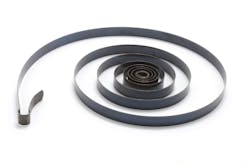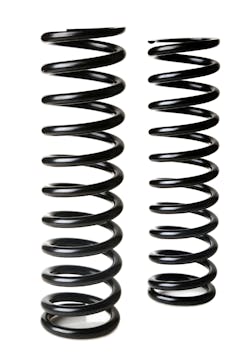A vast number of items in our modern world include a spring of some shape or size to ensure that the technology performs the desired function. Whether it’s the lock in a door, click in your computer mouse, or a life-saving medical device, springs are being created each and every day to make various technologies function properly.
Due to the array of functions that springs are required to carry out, a wide array of differences exists between each spring—a spring in a bicycle bell is going to look completely different than a spring used in oil refineries. Discussed in this article are some of the variants you will come across in the spring manufacturing sector, as well as in day-to-day life.
Common Springs
To first understand the differences between springs, especially ones that are incredibly similar, it’s important to become familiar with the most common types of springs. With each type of spring, there are a multitude of possibilities that give a once-linear piece of wire the ability to perform in a completely different way. Diameter, materials, and number of coils are the main factors that can alter a spring’s behavior.
• Compression springs are coiled to perform a “squeezing” action, whereby the spring gets shorter as a load is applied. These springs are commonly found inside electrical switches.
• When a load is applied to a torsion spring, it creates a twisting force that rotates the spring, thus enabling a bending function. You may find torsion springs within clipboards or clothing pins.
• Another extremely common and popular kind of spring is a tension, or extension, spring. This is designed to extend as a load is applied to it, explaining why the ends are usually loops or hooks. Trampolines and garage doors tend to have tension springs to enable their operation.
Different Purposes of Springs
The first thing to consider when choosing a spring is how springs are able to fulfill different purposes. The different processes and materials used to create them, as well as their finishes, ensure that each spring is a bespoke creation that performs its intended function.
By changing one factor within the manufacturing method, you can create something that is tailored. For instance, micro-coil technology is often thought of as solely targeted for the medical sector. This method essentially means that springs are created to meet minuscule dimensions for important and life-saving technology, such as for pacemakers or arterial widening.
However, retractable pens that you “click” on and off also need tiny springs to operate. Whereas springs used within the medical sector need to be created using medical-grade materials that are strong for their size, pens are often made using much cheaper methods to minimize cost to the consumer. Therefore, reinforced medical springs will usually be created using stainless-steel alloys such as platinum iridium and platinum tungsten, whereas springs for ballpoint pens can be made with galvanized iron.
Furthermore, springs for pens usually require fewer coils than medical devices. However, this depends on the exact specifications needed for the respective technology.
Creating and Harnessing Springs
With so many possibilities when it comes to making springs, various machines are used to ensure each one is created exactly for its required function. The majority of springs are created on a CNC (computer numerical control) machine. For instance, the KCT680 CNC coiling machine is used to manufacture compression springs, whereby the user can alter the size, number, and diameter of coils, as well as the distance between each coil.
Some of these variations aren’t always immediately noticeable to the naked eye. As a result, several industries have incorporated methods to avoid confusion when it comes to implementing their springs. For instance, in the gas industry, it’s vital that the heavy-duty springs they use aren’t confused with one another. Thus, they will implement a color-coding system to ensure that they aren’t mixed up. It is up to the spring manufacturer to paint on the specified colors so that the client knows which springs they are dealing with.
Taking Advantage of 3D Printing
Although the actual springs aren’t created using 3D printing, this kind of technology has proven hugely beneficial to the spring manufacturing industry. The design process is one element that spring manufactures are entrusted to perform. Although some clients will send specific required dimensions without details of the spring’s intended function, not all entrepreneurs are aware of the kind of spring that they need. As a result, they may not have the equipment to work out the specific dimensions they require down to the very last millimeter.
Therefore, the introduction of 3D technology and printing methods has allowed spring manufacturers to ensure that dimensions are correct on the first attempt, saving time and money.
Overall, 3D printing is typically employed in two distinct ways across the industry. The first is when a client sends a blueprint of their device so that spring manufacturers can print a prototype to work with. The manufacturers will then use the printed model to design and measure how a spring will fit to perform the specified function.
The second way is to create a gauge to ensure that no variations exist between springs. Manufacturing springs on a mass scale means that slight variations are often inevitable, but there is no scope to allow for these differences. By 3D printing a gauge, spring manufacturers can measure whether the spring is the right size and if the end of the wire (in a compression spring, for instance) finishes at the precise moment. Although CNC technology is extremely specific, the ends of the wire are often left intact for sanding by hand. Therefore, using a gauge ensures that all of the springs are the exact same size when finished.
Throughout each stage of the manufacturing process, it is possible for differences to prevail between springs. Whether the variations are broad or minuscule, it has opened the door to a range of technologies that would otherwise not be used.
Tim Parkinson, Chairman of Airedale Springs, has worked with the company for a number of decades, consistently developing and creating new springs to perform particular functions.â
About the Author
Tim Parkinson
Chairman
Tim Parkinson, Chairman of Airedale Springs, has worked with the company for a number of decades, consistently developing and creating new springs to perform particular functions.



